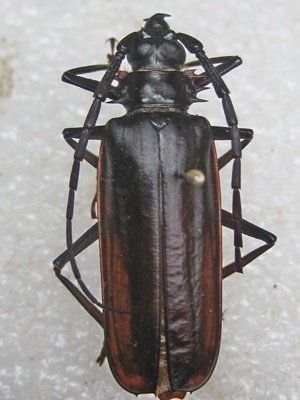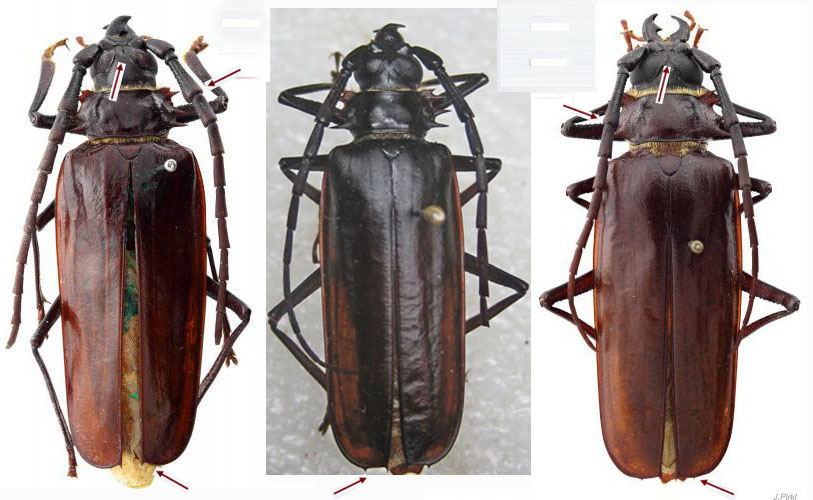| Author |
 Topic Topic  |
|
|
BillTyson
Member Rosenbergia
   
USA
1200 Posts |
 Posted - 08/05/2016 : 04:02:19 Posted - 08/05/2016 : 04:02:19



|

47.67 KB
Sonora, E. of Tecoripa, July, 31 mm.
Very small Derobrachus. |
Edited by - Capitaine on 13/05/2016 17:46:04 |
|
|
dryobius
Member Rosenbergia
   
USA
1887 Posts |
 Posted - 08/05/2016 : 13:51:49 Posted - 08/05/2016 : 13:51:49



|
| Since some of the diagnostic characters for Derobrachus are impossible to see in dorsal photographs, you will need to use the key in Santos-Silva's paper. Do you need the pdf? |
 |
|
|
BillTyson
Member Rosenbergia
   
USA
1200 Posts |
 Posted - 08/05/2016 : 16:03:02 Posted - 08/05/2016 : 16:03:02



|
| No, I have it but at times its very hard to use. This is such a little species, I thought someone might recognize it. thanks |
 |
|
|
Capitaine
Scientific Collaborator
   
France
1841 Posts |
 Posted - 10/05/2016 : 14:59:15 Posted - 10/05/2016 : 14:59:15



|
| Based on the picture with pronotum shape showing four lateral spines and the bi-spined apex of elytrae, I think it's a male of Derobrachus chemsaki (Santos-Silva, 2007). |
Claude |
 |
|
|
dryobius
Member Rosenbergia
   
USA
1887 Posts |
 Posted - 10/05/2016 : 19:34:55 Posted - 10/05/2016 : 19:34:55



|
Looks like a D. geminatus (= forreri) to me.
D. chemsaki does not have bispinose elytral apex. Look at the HT photo on Bezark's site. D. chemsaki has pilose meso- and metasternum, if I read the Portuguese description. |
 |
|
|
Capitaine
Scientific Collaborator
   
France
1841 Posts |
 Posted - 11/05/2016 : 11:26:00 Posted - 11/05/2016 : 11:26:00



|
Yes Dan, I agree with you, but in that case, what do you think about the following picture in Biolib:
http://www.biolib.cz/en/image/id253666/
If you have a look at the fourth antenal joint, (shorter and thicker ), this is quite different from Bill's specimen.
In fact, I think that the Biolib picture is D.hovorei, and there are a lot of confusion between D.geminatus and hovorei.. |
Claude |
 |
|
|
Francesco
Forum Admin
    
Luxembourg
9454 Posts |
 Posted - 11/05/2016 : 11:38:37 Posted - 11/05/2016 : 11:38:37




|
| Merci Claude, je vais changer le nome de cette espèce. |
 |
|
|
dryobius
Member Rosenbergia
   
USA
1887 Posts |
 Posted - 13/05/2016 : 01:34:52 Posted - 13/05/2016 : 01:34:52



|
Claude,
Derobrachus is a difficult and confusing genus, but before the revision by Santos-Silva in 2007, it was impossible to put names on some species. I still miss several species in my collection.
What were once called D. geminatus are now D. hovorei and what were once known as D. forreri are now D. geminatus. I believe there is possibly some hybridization in North American species, as sometimes the characters used to separate species are very subjective.
|
 |
|
|
Capitaine
Scientific Collaborator
   
France
1841 Posts |
 Posted - 13/05/2016 : 17:44:21 Posted - 13/05/2016 : 17:44:21



|
Yes Dan, considering that these close species are localised on a common territory, there is a probability for a genetic exchange.
However, for the time being, I follow the Santos-Silva's great work concerning the genus revision.

115.89 KB
On this picture you have left: D.hovorei (paratype RISNB), Bill'specimen center and geminatus right.
It seems evident to separate geminatus from hovorei in view of the differences relatives to the inter-ocular space and the shape of the third/fouth antenal joint of the two species.
D. forreri is now considered as synonym of D. geminatus.
Historically, I think that the the local name "Palo verde beetle" involving several (two at least) species didn't help for the species identification. |
Claude |
 |
|
|
BillTyson
Member Rosenbergia
   
USA
1200 Posts |
 Posted - 13/05/2016 : 23:18:38 Posted - 13/05/2016 : 23:18:38



|
| I did not know I was going to stir up so much interest when I listed this one. Many thanks for everyones input. I have two specimens from the same location and both are small and have the elytra with a satin finish. My series of gemminatus (the old leechi) are very glossy. My long series of hovori (the old gemminatus) are more satin finished. The location of my specimens is within the range listed by Silva for both species so I will abide by the decision made here of them being small geminatus. Again, thanks |
 |
|
| |
 Topic Topic  |
|


